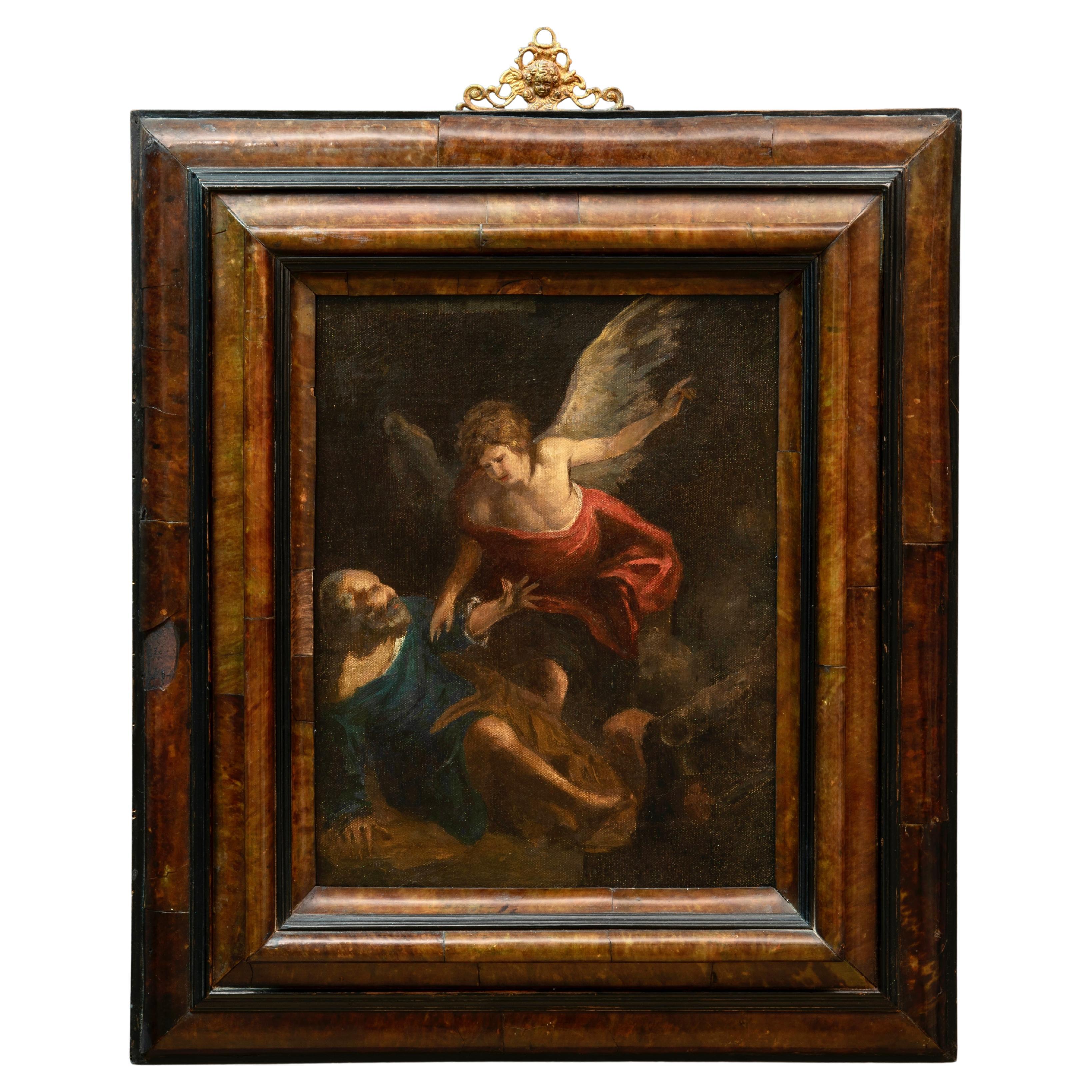Items Similar to 17th Century, Italian painting Allegory of the Spring Follower of Jacopo Bassano
Want more images or videos?
Request additional images or videos from the seller
1 of 20
17th Century, Italian painting Allegory of the Spring Follower of Jacopo Bassano
About the Item
Follower of Jacopo Da Ponte, called Jacopo Bassano (Bassano del Grappa, circa 1510 - Bassano del Grappa, 13 February 1592), 17th century
Allegory of the Spring
Measures: With frame: cm W 122,5 x H 89 x D 6,5. Canvas: cm W 106,5 x H 72
The painting, of great decorative effect and accompanied by a frame in carved wood and gilded not coeval, is the work of a painter, active in the mid-seventeenth century, follower of the celebrated Venetian school of Bassano da Ponte, family of painters who developed his prosperous workshop for over two centuries, between the fifteenth and advanced seventeenth century.
It depicts the allegory of Spring with all the peculiar activities of the season: in the foreground on the right is described the milking of goats, while on the left a hunter, with his dogs on a leash is ready for a hunt. The scenes are set in a hilly landscape with some birds flying among the buds of the trees. In the distance, to the right, the expulsion of Adam and Eve from Paradise.
It is a composition from the cycle The Four Seasons now returned to Jacopo da Ponte (called Bassano).
The series of painters from Ponte or Ponte, also known as Bassano, begins with Francesco il Vecchio, born in Bassano del Grappa between 1470 and 1480, late-fifteenth-century artist. He had four children, among them the famous Jacopo, founder of the Bassano school. Jacopo had eight children, including Francesco, Leandro, Giambattista and Girolamo, all painters in his father’s workshop. Jacopo was the initiator of a biblical-pastoral genre that had great fortune, engaging the workshop and the children in numerous variations. As the years passed, these paintings, sometimes taken from the New Testament, or cyclical compositions of the Seasons, Months, Elements, to satisfy the increasingly dense demands of the bourgeois patronage, became a mixture of styles and subjects, with phenomena of mutual assimilation and imitation, within a real proto-industry of images. The Bassano painting did not end with the death of the four sons of Jacopo: it was transmitted instead to their descendants for two generations. The dynasty became extinct in 1661 and activity ceased permanently.
The success of their productions, defined by critics as genre painting and/or biblical-pastoral painting, largely coincided with the fame of the name Bassano or Bassano. The artistic character of their works is distinguished by a "genre" iconography that rarely allowed them to be identified as traditional paintings because the Bassano did not paint them following the established canons of religious history painting.
The fortune of Bassano painting was great and already in the seventeenth century many painters did not scruple to copy, imitate and falsify the paintings and themes of Bassano, thus contributing to often create an inextricable attribute tangle.
The Four Seasons are certainly among the most representative works of Bassano iconography. The metaphorical structure seems obscured by the representation of pastoral environments and rural works. However, against the background of all four canvases is a scene from the Old Testament: in the case of Spring, it depicts the Expulsion of Adam and Eve from earthly Paradise.
Jacopo Bassano uses a simple compositional scheme: against the background of a landscape, the activities of people, pets and equipment used described with vivid narrative realism. The painter portrays the landscapes in the four canvases, as a series of studies on light that changes during the day, creating interconnecting and complementary effects between the works. The changing light of the day becomes more and more evident: Spring begins the series bathed with dawn light, Summer has the full light of the day, while Autumn reveals the last light that changes from the warm tones of the afternoon towards dusk. In Winter, the evening gives way to the night, the waning light reveals the bright splendor of the white peaks of the mountains against the dark night sky. In this series, Jacopo’s appreciation of nature is evident, combined with his interest in the characteristic activities of rural and domestic life.
The most significant group of paintings representing this iconographic theme is now preserved in the Kunst Historisches Museum in Vienna. The series of the Four Seasons by Jacopo Bassano, conceived by the author in 1570, belonged to the famous collection of Archduke Leopoldo Guglielmo (1614-1656). The Archduke’s collection later became a significant part of the present collection of the Kunsthistorisches Museum in Vienna: Spring, Summer, Autumn and Winter (inv. nn. 4303, 4302, 4304, 2869). In the same place is also preserved the series of the Four Seasons by the son of Jacopo Bassano, Francesco, of 1580.
The representation of the months and seasons became the subject of entire pictorial cycles, elaborated in several versions. If the different seasons show absolutely similar characteristics, in the bucolic intonation, in the landscape gently sloping towards blue hills, in the cut of the scene, there are in fact no real replicas or copies of the same subject.
The success of the cycle of the Four Seasons is certainly due to the presence of numerous engravings whose prints circulated in a widespread and widespread way.
In 1660, David Teniers the Younger published his Theatrum Pictorium, in which he recorded most of the collection of Italian paintings that Archduke Leopold Wilhelm of Austria had collected in the palace of Coudenberg in Brussels appointed as governor of the Spanish Netherlands. There are several cycles of prints, some probably taken from the same engravings that circulated. An example is the one engraved by Jan Sadeler I and printed by Jacques Callot, whose printed sheets show the subjects again in contrast to the engravings of Teniers, and therefore in the same direction as the paintings.
There are also other famous series of the Seasons, one preserved at the Sforzesco Castle in Milan, one at the Museo Nacional del Prado in Madrid, one at the Galleria Nazionale in Palazzo Spinola in Genoa, and one at the Galleria Borghese in Rome.
Presumably, the painter of the painting in question, had the opportunity to see and therefore to be inspired by paintings taken from Viennese works or, in the workshop, he owned one of those prints.
We apologize for any translation errors from Italian. Please contact us to have the full expertise, in Italian.
- Similar to:Jacopo Bassano (Painter)
- Dimensions:Height: 35.04 in (89 cm)Width: 48.43 in (123 cm)Depth: 2.76 in (7 cm)
- Style:Baroque (Of the Period)
- Materials and Techniques:
- Place of Origin:
- Period:Late 17th Century
- Date of Manufacture:Late 17th Century
- Condition:Wear consistent with age and use.
- Seller Location:IT
- Reference Number:1stDibs: LU4405238203342

About the Seller
5.0
Gold Seller
These expertly vetted sellers are highly rated and consistently exceed customer expectations.
Established in 1980
1stDibs seller since 2019
41 sales on 1stDibs
Typical response time: 1 hour
- ShippingRetrieving quote...Ships From: Italy
- Return PolicyA return for this item may be initiated within 7 days of delivery.
More From This SellerView All
- 17th Century, Italian Painting with Virgin and Child by Follower of Van DyckBy Anthony van DyckLocated in IT17th century, Italian painting with virgin and childr by Follower of Sir Anthony van Dyck cm W 90 x H 113; cornice cm W 111 x H 135 x D 7 The canvas depicts the Madonna with the Chi...Category
Antique Late 17th Century Italian Baroque Paintings
MaterialsCanvas
- 17th Century, Italian Painting with Battle attributed to Marzio MasturzoLocated in ITMarzio Masturzo, attributed (Active in Italy - in Naples and Rome- in the second half of the 17th century) "Battle between cavalry and vessels with fortified city on the left" ...Category
Antique Late 17th Century Italian Baroque Paintings
MaterialsCanvas
- 17th Century, Italian Painting with Saint Cecilia with Angels in ConcertLocated in IT17th century Roman school, Santa Cecilia with angels in concert, oil painting on canvas The valuable painting, in excellent condition, depicts Sa...Category
Antique 17th Century Italian Baroque Paintings
MaterialsCanvas
- 17th Century, Italian Painting with Battle Between Christian and Turkish CavalryLocated in IT17th century, Italian oil on canvas painting with battle between Christian and Turkish cavalry The oil on canvas painting depicts a battle between Christian and Turkish cavalry. C...Category
Antique Mid-17th Century European Baroque Paintings
MaterialsCanvas
- 17th Century, Italian Painting with Still Life with Fruit, Dogs and CatLocated in IT17th Century, Italian painting with still life with fruit, dogs and cat Measurements: With frame cm W 93 x H 75.5 x D 4; Frame cm W 82.5 x H 66.5 The...Category
Antique 17th Century Italian Baroque Paintings
MaterialsCanvas
- 17th Century, Oil on Canvas Dutch Painting with Hunting SceneLocated in IT17th century, oil on canvas Dutch painting with hunting scene Oil on canvas. Dimensions: frame W 81 x H 75 cm, canvas 58 x 49 cm The oil on canvas painting depicts a hunting scene in a predominantly rocky landscape. On the right, at the center of the canvas is depicted a group of characters dressed for hunting according to the 17th century fashion of northern Europe. The men stop with their horses and dogs; one of them points downstream, while another one sounds a Horn, used as a call sign in hunting trips. In the foreground on the left another character sits on the ground, turning his back on the observer, in the company of two hunting dogs. The scene takes place in the open air, in a rocky context and the landscape widens towards a valley, beyond which the horizon is lost among mountain reliefs with blue tones. The bright sky is characterized by some clear clouds. The color palette of the canvas is characterized by brown tones; a ray of light that emphasizes the right group, where it stands out illuminated a dog and the spotted steed on which is rising a man with a red mantel...Category
Antique Late 17th Century Dutch Baroque Picture Frames
MaterialsCanvas
You May Also Like
- 17th Century PaintingLocated in Miami, FL17th century painting J.Castano 17th century SpainCategory
Antique 17th Century Baroque Paintings
MaterialsCanvas
- 17th century French School, follower of Charles and Henri BEAUBRUNBy Europa AntiquesLocated in Madrid, ES17th century French School, follower of Charles and Henri BEAUBRUN Presumed portrait of Anne Marie Louise d'Orléans, Duchesse de Montpensier Oil on canvas (Re-backed, restorations)...Category
Antique 17th Century French Baroque Paintings
MaterialsPaint
- 17th Century Italian Oil PaintingLocated in Atlanta, GAAn intriguing Italian 17th century oil on canvas painting. A skeleton with a cornucopia of gold pieces. Divittarum Jactantia Quid - "What is the boasting of the rich?".Category
Antique 17th Century Italian Paintings
MaterialsCanvas
- Pietro Novelli 17th Century Italian Religious PaintingBy Pietro NovelliLocated in Roma, ITImportant oil on canvas painting depicting Saint Peter in prison being freed by the Angel. The original is kept at the Regional Gallery of Palazzo Abatellis in Palermo. It comes fro...Category
Antique 17th Century Italian Baroque Paintings
MaterialsBronze
- German 17th Century Painting Of The MadonnaLocated in Atlanta, GAAn exquisite 17th century oil painting of the Assumption Of The Virgin Mary. Magnificently executed in oil on a hand woven canvas. Stunning.Category
Antique Mid-17th Century German Paintings
MaterialsCanvas
- 17th Century Italian Flemish Oil on Canvas Painting of Adoration of the MagiLocated in North Miami, FL17th Century Italian Flemish oil on canvas painting depicting the Adoration of the Magi. Early Flemish painting was contemporary to the development of the early Renaissance in Italy. In the middle of the 15th century Italy...Category
Antique 17th Century Italian Baroque Paintings
MaterialsWood, Giltwood, Paint





